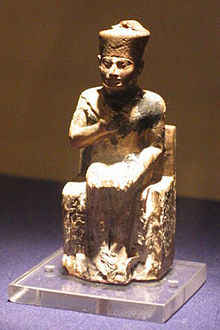Cheops
| Khufu | |
|---|---|
| Cheops, Suphis, Chnoubos, Sofe | |

Statue of Khufu in the Cairo Museum
|
|
| Pharaoh | |
| Reign | 2589–2566 BC (63 years according to Manetho); (23 or 46 years according to modern historians)(4th Dynasty) |
| Predecessor | Sneferu |
| Successor | Djedefre |
| Consort | Meritites I, Henutsen, Rekhetre ? |
| Children | Kawab, Djedefhor, Hetepheres II, Meritites II, Meresankh II, Baufra, Djedefra, Minkhaf I, Khafre, Khufukhaf I, Babaef I, Horbaef, Nefertiabet, possibly Khamerernebty I, possibly Nefermaat II |
| Father | Pharaoh Sneferu |
| Mother | Queen Hetepheres I |
| Died | 2566 BC |
| Monuments | Great Pyramid of Giza, Khufu ship |
Khufu (/ˈkuːfuː/ KOO-foo), originally Khnum-Khufu (/ˈknuːmˈkuːfuː/ KNOOM-koo-foo), is the birth name of an ancient Egyptian pharaoh, who ruled during the Fourth Dynasty in the first half of the Old Kingdom period (26th century BC). Khufu was the second pharaoh of the 4th dynasty, he followed his possible father, king Sneferu, on the throne. He is generally accepted as having commissioned the Great Pyramid of Giza, one of the Seven Wonders of the Ancient World, but many other aspects of his reign are rather poorly documented.
The only completely preserved portrait of the king is a three-inch high ivory figurine found in a temple ruin of later period at Abydos in 1903. All other reliefs and statues were found in fragments and many buildings of Khufu are lost. Everything known about Khufu comes from inscriptions in his necropolis at Giza and later documents. For example, Khufu is the main actor of the famous Papyrus Westcar from the 13th dynasty.
...
Wikipedia
